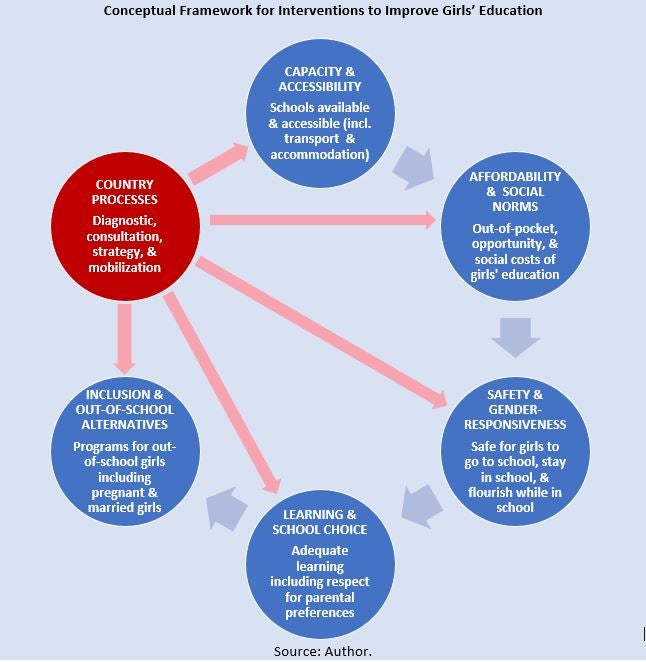 A female student sitting in a classroom.
A female student sitting in a classroom.
Education is fundamental for improving a wide range of development outcomes for women. Over the last two years, the World Bank published a series of reports at the global, regional, and country levels on the benefits of investing in girls’ education. Globally, the cost in lost lifetime earnings from girls not completing their secondary education is estimated at up to $30 trillion. In sub-Saharan Africa, apart from losses in earnings, low educational attainment for girls is also associated with a higher prevalence of child marriage and early childbearing, and higher risks for children of young mothers to be stunted or die before age five, among others. Country level studies suggest that these negative effects are pervasive, as illustrated in recent reports for Malawi, Tanzania, Uganda, and Chad-Mali-Niger-Guinea.
This week, ahead of International Women’s Day, the World Bank published a new study showing that achieving gender equality in earnings could generate a ‘gender dividend’ of up to $172 trillion in terms of higher lifetime earnings for women. This estimate relies on many assumptions, and should therefore be seen as indicative only, but it shows how large the negative effects of gender inequality are. The study also looks at the impact of gender inequality on other domains, including educational attainment. In low income countries girls often continue to lag behind boys in educational attainment due to social norms. Improving education for girls, and thereby delaying child marriage and early childbearing could make a major difference towards achieving gender equality.
What can be done to achieve gender equality, and in particular improve education opportunities for girls while delaying child marriage and early childbearing? There is no magic bullet, but based on reviews of the literature, a simple conceptual framework can help policy makers and school leaders identify promising options for interventions. The framework provided below considers five sequential steps that are required for girls to go to school and learn while in school: (1) schools must have the capacity to welcome girls and be accessible; (2) going to school must be safe for girls, namely violence against girls in and on the way to school must be prevented; (3) schools must be affordable considering the out-of-pocket, opportunity, and potential social costs of sending girls to school; (4) girls must be able to learn while in school – this refers not only to traditional academic subjects but to socio-emotional and life skills, taking into account parental preferences for what children should learn in school; and finally (5) pregnant and married girls should be allowed to remain in school, and second chance programs should be available for those who cannot remain in school due to their circumstances. In addition, the framework below highlights the fact that adequate country processes (having a proper diagnostic, consultation, and strategy) are required to inform interventions related to each of these five steps.

Governments with the support of the international community have a key role to play in providing opportunities for girls’ education. But one should not forget that civil society organizations, including NGOs implementing programs on the ground, also play a fundamental role, not only to “reach the last mile”, but also to test innovative approaches that can then be scaled up by governments.
On the occasion of International Women’s Day, the Global Partnership for Education, the World Bank, and Rotary International are hosting an event today on Equality for Education (recording will be available). Speakers include Alice Albright, CEO of the Global Partnership for Education, Keiko Miwa, Regional Director for Human Development at the World Bank, and three Rotarians: Geeta Manek, Chair of Rotary International’s Joint Committee on Partnerships, Carolyn Johnson, Vice Chair of the Literacy Rotary Action Group, and Brenda Erickson, from the Rotary Club of Peachtree City. All will share their experiences in implementing innovative solutions for improving girls’ (and boys’) education.
If you are interested in knowing more, or would like to contribute in some way, please contact me. We just created this week the Rotary Club of Washington Global with a core group of professionals based in Washington DC as well as members from other locations in the US and abroad. Our aim is to share knowledge on best practices with nonprofits and other organizations to help them implement great service projects, including for girls’ education.


Join the Conversation